 button is pressed on the main toolbar).
button is pressed on the main toolbar).
Bulk streams represent flow of bulk material (e.g. water, air, etc.). Bulk streams are only allowed to hook onto bulk ports of procedure icons (see Unit Procedure Ports). The flowrate is specified and reported in the usual flowrate units (kg/h or L/h if the plant mode of operation is continuous and kg/batch or L/batch if the plant’s mode is batch). The material can be in one or more liquid phases, solid or gaseous phase, but the application only distinguishes a vapor (gaseous) and a single liquid/solid phase (two phase system). Every component in the stream may distribute differently between the liquid/solid phase and the vapor phase. Each component’s vapor fraction represents the percentage of that component that is considered to be in the vapor phase of the stream. The application may use a simple criterion (e.g. based on a component’s normal boiling point and the stream’s temperature) to determine if the component is in gaseous or liquid/solid state or it may use other more elaborate criteria. The criterion used throughput the process can be as one of the process defaults (see Physical State Calculation Options) but it can also be overwritten for a given stream from the ‘Physical State’ tab of its i/o simulation dialog (for input streams, see Stream Physical State Calculation Options; for intermediate and output streams, see Discrete Streams).
Most properties of bulk input streams are provided by the user whereas for output and intermediate streams only the physical-state specifications are editable. The flowrate, composition, temperature and pressure of intermediate and output streams are determined by the simulation outcome. You can inspect the properties of any stream by bringing up its input/output (i/o) simulation dialog.
► To display the i/o simulation dialog of a stream...
1. Make sure you are in select mode (the  button is pressed on the main toolbar).
button is pressed on the main toolbar).
2. Right-click on the stream to display its context menu; then select Simulation Data.
As a shortcut to the above procedure, you can bring up the i/o simulation dialog of a stream by simply double-clicking on it.
|
|
When viewing the composition table of an intermediate stream notice that only components with amounts above a set threshold are shown. The threshold below which a component is assumed to be practically zero and not shown on the table can be set from the. Physical Units Options: Numerical Tab.(zero flow threshold). |
Input streams represent material that is directly fed into the process. The user must initialize the amount, composition and state of the material as it enters the process.
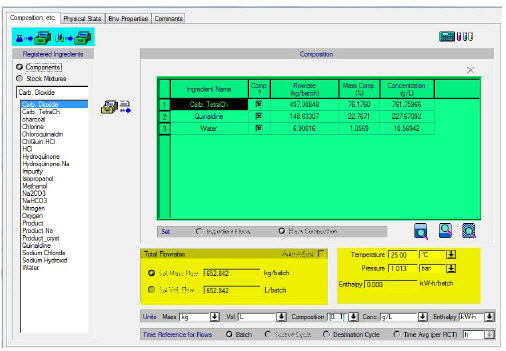
The ‘Composition, etc.’ tab for a bulk input stream.
You can set the above information by visiting the i/o simulation dialog for an input stream. The information is presented on the ‘Composition, etc.’ tab (Input Stream Dialog: Composition, etc. Tab). As shown in The ‘Composition, etc.’ tab for a bulk input stream., this tab displays the state of an input stream as a whole (temperature, pressure, total flow - yellow fields in The ‘Composition, etc.’ tab for a bulk input stream.) as well as component-specific information (mass flow, weight percent, concentration and perhaps extra-cellular fraction for each ingredient currently included in the stream - green fields in The ‘Composition, etc.’ tab for a bulk input stream.). When a stream property is not editable (e.g., the enthalpy property), it is displayed in a grayed framed box. Notice that by clicking with the mouse inside such grayed frames, you cannot get into edit-mode and type new values in those fields. These properties are updated automatically by the application and are included on the dialog for display purposes only.
The user-editable stream properties in this tab are:
3. Temperature
4. Pressure
5. Composition
To specify the temperature or pressure of the stream simply click in the corresponding field and type a value. The composition of the stream, on the other hand, is specified in two steps:
a) First, introduce all the ingredients (components and/or mixtures) that make up the stream.
If you wish to introduce a component, then first click on the ‘Components’ button under the ‘Ingredients’ box on the left, to display the list of registered components. Then, select the desired component and click on the  button (or simply double-click on the component’s name). Notice that the table of ingredients (displayed on the right) will expand by one line (unless the ingredient is already there). The newly added ingredient may not appear last as the ingredients are sorted by their ‘Local Name’. If you wish to introduce a stock mixture, first click on the ‘Mixtures’ button of the ‘Ingredients’ box to display all the registered stock mixtures, then click on the
button (or simply double-click on the component’s name). Notice that the table of ingredients (displayed on the right) will expand by one line (unless the ingredient is already there). The newly added ingredient may not appear last as the ingredients are sorted by their ‘Local Name’. If you wish to introduce a stock mixture, first click on the ‘Mixtures’ button of the ‘Ingredients’ box to display all the registered stock mixtures, then click on the  button.
button.
If you wish to remove an ingredient already present in the composition table, select the ingredient in the table and click on the  button.
button.
b) For each ingredient, specify its relative participation in the composition of the stream. There are two different ways this can be accomplished:
- Set the flowrate of each ingredient (this indirectly sets the total stream flowrate), or
- Set the total stream flowrate and the mass or mole percentage of each ingredient.
You can click on ‘Set Ingredient Flows’ or ‘Set Mass Composition’ (shown under the ingredient composition table) to dictate your preference.
|
|
The list of ingredients (pure components and stock mixtures) available to be included in the composition of an input stream include only those that have already been registered. If you don’t find the ingredient needed, you must register them first through the Pure Component Registration Dialog or the Stock Mixture Registration Dialog. Instead of exiting the stream’s initialization dialog and selecting Tasks } Pure Components } Register, Edit/View Properties..., or Tasks } Stock Mixtures } Register, Edit/View Properties...,for convenience, two buttons allow a user to invoke either of the above interfaces without leaving the stream dialog (shown in The ‘Composition, etc.’ tab for a bulk input stream. above highlighted in blue). After visiting either of the aforementioned interface to add a component (or a mixture), upon return to the stream dialog, the component (or mixture) is readily available in the list of ingredient options and can be added in the composition list of the stream. |
For some simulations, tracking the activity level of a stream is important. For such cases, an Activity Reference component must have been selected (see Pure Component Registration Dialog). If that is the case, then another field is shown on the stream’s ‘Composition tab’ (see The ‘Composition, etc.’ tab for a bulk input stream with Activity and Extra-Cellular Column.):.

The ‘Composition, etc.’ tab for a bulk input stream with Activity and Extra-Cellular Column.
Please note that the ‘Activity’ value is always being calculated by the program (based on the presence of the ‘Activity Ref. Component’ in the composition of the stream, and therefore, the value will always be shown grayed out and will not be available for editing.
Also, if a ‘Primary Biomass’ component has been selected in the Component Registration dialog (see Pure Component Registration Dialog) along with a ‘Water’ component and a water content percentage, then the composition table for each stream has another column that displays the extra-cellular percentage of each component (see purple highlight in The ‘Composition, etc.’ tab for a bulk input stream with Activity and Extra-Cellular Column.). This percentage represents the portion of that component that can be found outside the “Primary Biomass” cell; the rest of that component is assumed to be part of the composition of the cells, and therefore, when an operation step diverts part (or all) of the biomass cells to a separate stream, it carries with it an amount of each component that is dictated by the intra-cellular percentage of that component. Please note that for process simulations that do not keep track of intra- and extra- cellular presence of components (and therefore do not have a definition for the ‘Primary Biomass’ component, the above columns are not shown.
|
|
When setting the total stream flowrate and the ingredient percentages, you can choose to set either the total mass or volumetric flowrate (pick ‘Set Total Mass Flow’ or ‘Set Total Vol Flow’ in the ‘Flowrates’ box). When setting the flowrates of individual ingredients, you must always set the mass flow. The units for setting and viewing all of stream’s properties are chosen based on the default settings for the process (see Physical Units Options) but they can be customized for a given stream through this dialog as well. If you make a choice for units that is different from the default choice, the application will record your choice for that stream and use it every time you view the properties of that stream. |
Sometimes users may not know the mass percentage of components in an input stream, but instead they may know the concentration of one (or more) components in the stream. Even though the stream’s i/o dialog displays the concentration of each component directly on the composition table, it does not allow you to click-and-edit it directly. The main reason is that while the only restriction that exists when specifying individual mass percentages is that they all add up to 100%, concentrations on the other hand are related to each other and the stream’s density and therefore cannot be all set independently of each other. SuperPro Designer offers a utility, the Target Concentration Calculator Dialog, that can assist the user in determining the stream’s composition in order to meet certain concentration targets. You an invoke the Target Concentration Calculator Dialog by clicking on the  button shown above the composition table.
button shown above the composition table.
If the user has indicated interest in tracking the ‘Dry Matter’ (or Dry Solids) content throughput its process modelEnable Dry Mass Options, then an extra check box appears at the top right corner of the Composition table (see yellow highlight in Extra, Dry Solid Related Properties Shown on an Input Stream’s Composition Dialog when Dry Matter Tracking is Active.):.
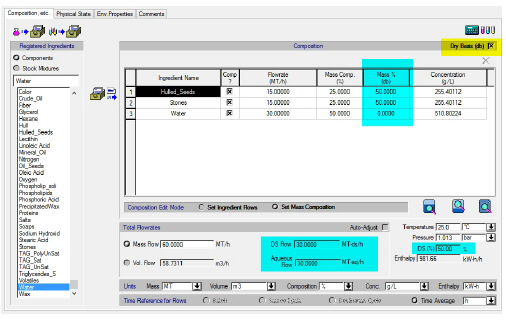
Extra, Dry Solid Related Properties Shown on an Input Stream’s Composition Dialog when Dry Matter Tracking is Active.
When that option is checked, the following extra information about the stream appear (see the blue highlights in Extra, Dry Solid Related Properties Shown on an Input Stream’s Composition Dialog when Dry Matter Tracking is Active.):
● Dry Solids Flow (DS Flow)
● Aqueous Flow
● Dry Solids Percentage (DS %)
● Mass (or Mole) Composition Percentages on Dry Basis (% db)
If none of the ingredients have any dry solid content, then the above option is not active. Similarly, the above option is not active, if one of the ingredients is a mixture that has some ingredients tagged as dry matter and some not (assumed aqueous).
If the conditions (temperature, pressure and composition) are such that two phases may exist, the composition tab shows the total composition (for both phases). If you wish to view the elemental (pure component) composition for the stream, you have three options:
1. Click on  to view the component-based composition of what the application considers as the liquid/solid phase of the stream.
to view the component-based composition of what the application considers as the liquid/solid phase of the stream.
2. Click on  to view the component-based composition of what the application considers as the gaseous phase of the stream.
to view the component-based composition of what the application considers as the gaseous phase of the stream.
3. Click on  to view the component-based composition for the entire stream (both phases).
to view the component-based composition for the entire stream (both phases).
Note that the application determines the state of each component based on its physical state options settings (through the Bulk Input Stream Dialog: Physical State Tab). The distribution of each component to the liquid/solid or gaseous state also affects the density of the stream and therefore the dependency between the mass flowrate and volumetric flowrate of the stream
|
|
When the plant mode of operation is set to batch (see Process Operating Mode: Batch vs. Continuous), stream flows can be displayed on a per-batch, per-destination-cycle (if there's a destination procedure), per-source-cycle (if there’s a source procedure) basis or on a per-time average Recipe Cycle Time basis. When the overall mode of operation is set to continuous, all stream flowrates are displayed on a per-time-average basis (either second, minute, hour, day or week). However, there is one exception: streams that appear as inputs to a unit procedure set to operate in batch mode (e.g. a batch distillation procedure, or a batch filtration operation), will display their flows in amounts/cycle (of the destination procedure) even in continuous processes. |
.
Sometimes it is convenient to initialize the contents of an input stream such that they match exactly the contents of another (input, output or intermediate) stream.
► To initialize an input stream based on the composition of another stream...
1. Make sure you are in select mode (the  button is pressed on the main toolbar).
button is pressed on the main toolbar).
2. Select Copy Contents from the source stream’s context menu.
3. Locate the input stream that you wish to be initialized, and select Paste Contents of <source-stream-name>.
|
|
The command Paste Contents of <Source-Stream-Name> is only available as part of the context menu of input streams only and while the source stream has not been deleted. |
Some input streams may need to have their total flowrate indirectly set by the application (as part of the simulation calculations) in order to satisfy some other requirement. For example, consider a input stream providing material for a wash operation in a chromatography column. The amount of wash is typically dictated by the user on the operation’s i/o simulation dialog and it is typically expressed in ‘Column or Bed Volumes’, therefore the actual amount (in L/h or L/batch) will not be known until the M&E balances are executed. Also, consider a simply ‘Charge’ operation where the user has dictated the amount to be charged on the i/o simulation dialog of the operation. Once again, the amount of material that needs to be carried in by the stream servicing that charge needs to be set indirectly to match the user’s choice. For simple circumstances like those mentioned, the application automatically checks the ‘Auto-Adjustable’ flag of the input stream associated with the operation. There are also other, more involved circumstances where the back-propagation calculation mechanism may require certain input streams to have their ‘auto-adjustable’ flag set (see Back-Propagation: Sources (Initiators) & Sinks (Terminals)). For those circumstances, the user must set the flag him/herself.
|
|
When the application itself has turned the ‘auto-adjustable’ flag on, the ‘Auto-Adjustable’ check box is shown as checked and the setting is disabled; in other words, the user cannot un-check it. Only when the conditions that require this setting are removed (e.g. the operation that is serviced by that stream is deleted, or the user assigns a different stream to carry out the operation - through its i/o dialog) then the flag will be removed and the setting may become editable once again. |
When the ‘auto-adjustable’ flag of an input stream is set (checked), then the application will set the total flowrate amount to ‘100 kg/batch’ (or ‘100 kg/h’ if the plant’s operating mode is continuous) and it will prevent the user from editing the value. The composition must only be specified by providing the mass percentage of each ingredient (but not their flowrate - this mode is also disabled).
Unlike input streams, the composition, temperature and pressure of intermediate and output streams is calculated by the outcome of the M&E balances, therefore, when displaying the i/o simulation dialog for such streams, the information presented on the ‘Composition, etc.’ tab (Bulk Intermediate/Output Stream Dialog: Composition, etc Tab) is for viewing only. Notice that all the fields used to display the mass flow, volumetric flow, temperature, pressure and enthalpy are grayed out and you cannot click to edit them (see The ‘Composition, etc.’ tab for a bulk intermediate or output stream with activity and extra-cellular information displayed).
The only settings that can be changed are the viewing preferences. At the top of the dialog, you may choose to:
a) View the composition of the entire stream
b) View the composition of only the portion of the stream that the application perceives as the liquid/solid phase, at the current stream conditions and using the physical state criteria for the stream, see Stream Physical State Calculation Options.
c) View the composition of only the portion of the stream that the application perceives as the vapor phase, at the current stream conditions and using the physical state criteria for the stream, see Stream Physical State Calculation Options
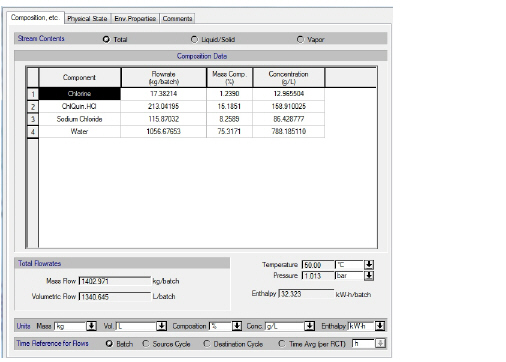
.
The ‘Composition, etc.’ tab for a bulk intermediate or output stream.
The only settings that can be changed are the viewing preferences. At the top of the dialog, you may choose to:
a) View the composition of the entire stream
b) View the composition of only the portion of the stream that the application perceives as the liquid/solid phase, at the current stream conditions and using the physical state criteria for the stream, see Stream Physical State Calculation Options.
c) View the composition of only the portion of the stream that the application perceives as the vapor phase, at the current stream conditions and using the physical state criteria for the stream, see Stream Physical State Calculation Options.
|
|
After the solution of the M&E balances, intermediate and output streams are assigned enthalpy values which are calculated based on the specific PS calculation options of their associated procedures. These enthalpy values will be respected by the streams at the expense of respecting a given temperature. In practice, this means that if the PS calculations options of an intermediate or output stream are different than the respective options of their associated procedures, deviations in the displayed temperature may be observed. This respect-enthalpy behavior, however, is necessary in order to eliminate the generation (or loss) of enthalpy content in a process that would otherwise occur because of the discontinuity between PS calculation options between a stream and its associated procedure. |
d)
Near the bottom of the dialog, you may pick the units of choice for the presentation of mass & volume quantities, concentrations, composition percentages and flow time reference. When the streams is first displayed the defaults as set for the entire process are used (see Physical Units Options), but users may overwrite the defaults for any given stream next time the stream’s i/o simulation dialog is presented.
The last viewing choice that can be made is the time reference for the flow values. The exact choices depend on:
a) The operating mode of the process (see Process Operating Mode: Batch vs. Continuous).
b) The operating mode of the source procedure (if it exists) and the destination procedure (if it exists). For more on how to view and/or change the procedure’s operating mode, see Unit Procedure Operating Mode.
It should be noted that if the user has specified an “Activity Reference” component and a “Primary Biomass” component in the , then the there are “Composition, etc.” tab of an intermediate (or output) streams appears as shown in The ‘Composition, etc.’ tab for a bulk intermediate or output stream with activity and extra-cellular information displayed below.
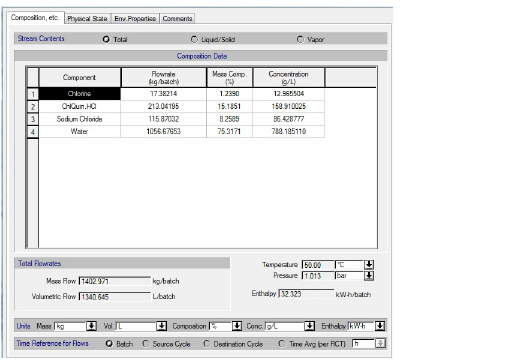
.
The ‘Composition, etc.’ tab for a bulk intermediate or output stream with activity and extra-cellular information displayed
When user has activated the tracking of dry matter in the process modelEnable Dry Mass Options another choice is also available as a checkbox at the upper right corner of the composition data table: “Dry Basis” (see yellow highlight shown in The ‘Composition, etc.’ tab for a bulk intermediate or output stream with activity and extra-cellular information displayed.
When this option is checked, and assuming some of the components present in the stream are included in the dry matter family of components (therefore, its dry solid content will be non zero), the following extra properties are displayed:.
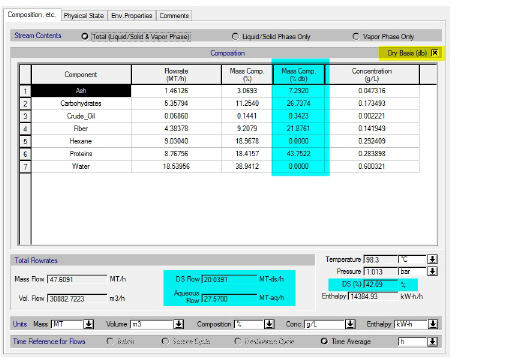
.
The ‘Composition, etc.’ tab for a bulk intermediate or output stream when tracking of dry matter is activated.
● The Dry Solids Flow (DS Flow)
● The Aqueous Flow (the difference between the total mass flow and the DS Flow)
● The Dry Solids Percentage (ration of DS Flow / Total Flow in percentage format)
● The Mass (or Mole%) on Dry Basis (% db) representing the percentage composition of this component as part of the dry solid flow only (not the total flow) of the stream.
Note that the percentage composition of non-solids (components belonging to the aqueous phase) is displayed as 0.0 % db.
Material in streams is considered to be in either vapor or liquid/solid state. For each bulk stream, SuperPro Designer calculates the Physical State (PS) of each component by either a simplified component-specific set of criteria (i.e., the Shortcut PS Toolbox) or by an elaborate VLE Model (i.e., the Rigorous PS Toolbox). A detailed description of the physical state calculation options is given in Physical State Calculation Options.
|
|
The PS of a stream is indicated by the vapor fractions percentages of its components. The component vapor fraction (i.e., the moles of the component in the vapor phase divided by the total moles of the component) must not be confused with the molar fraction of the component in the vapor phase (i.e., the moles of the component in the vapor phase, divided by the total moles of all components in the vapor phase). |
|
|
In principle, the PS calculation options of streams have only an indirect impact on the simulation outputs through the calculation of their enthalpy content. In other words, the overall energy balance around a procedure will calculate the enthalpy content of the input streams to that procedure based on the PS calculation options of these streams. |
By default, every bulk Input Stream in the process is initialized with the Shortcut PS calculation toolbox while every Intermediate/Output stream is assigned with the PS Toolbox of its associated unit procedure. It is possible to deviate from the default settings for the calculation of the physical state of streams in one of the following ways:
1. Modify the assigned PS Toolbox. While the Shortcut PS Toolbox offers a quick way to determine the physical state of a stream, the Rigorous PS Toolbox calculates the distribution of components in the vapor and liquid/solid phase in a more realistic manner. As a rule of thumb, the Shortcut Toolbox should be used when the accuracy of physical state calculations is not a primary concern or when no change of phase occurs in the process.
2. Modify the options of the assigned toolbox. For example, it may be necessary to change the Shortcut PS Toolbox V/L split criterion of a component (e.g., ammonia) from the default Normal Boiling Point to Liquid/Solid Only as it may be known that, at the conditions of the stream, all ammonia present in the mixture is dissolved in the liquid phase. On the other hand, given a stream that uses the Rigorous PS Toolbox (e.g. a mixture of hydrocarbons for which the binary interaction coefficients are readily available), an EOS model (e.g., the Peng-Robinson or the SRK) is best suited than the default Raoult’s law.
► How to select between the Shortcut or the Rigorous Toolbox...
1. While in select mode (i.e., the  button is pressed on the main toolbar), double-click on the specific stream whose Physical State calculation options you wish to change. Alternatively, right-click in the stream and select Simulation Data.
button is pressed on the main toolbar), double-click on the specific stream whose Physical State calculation options you wish to change. Alternatively, right-click in the stream and select Simulation Data.
2. Visit the Physical State Tab.
3. Check the Overwrite checkbox in the Physical State (PS) Calculation Options frame (see Selection between the Shortcut and the Rigorous Toolbox for the calculation of the stream’s physical state.).
4. Select between the Shortcut or Rigorous PS Toolbox option.

Selection between the Shortcut and the Rigorous Toolbox for the calculation of the stream’s physical state.
|
|
For Intermediate/Output Streams, the PS toolbox selection and options are, by default, imposed by their associated procedure. This means that any change to the procedure’s PS calculation options is automatically propagated to the stream. Checking the Overwrite option allows the stream to differentiate its behavior and adopt a different set of PS calculation options from its associated procedure. As a consequence, any change to the PS calculation options of the procedure will not be propagated to the stream. |
|
|
For Input Streams, the PS toolbox options (but not the PS Toolbox selection) are, by default, imposed (inherited) by the process file (i.e., any change to the process file’s PS Toolbox Options is automatically propagated to the stream). Checking the Overwrite option allows the stream to differentiate its behavior and adopt a different set of PS calculation options from the process file. As a consequence, any change to the PS calculation options of the process file will not be propagated to the stream. |
► How to customize the Shortcut Toolbox options...
1. While in select mode, double-click on the stream whose options you wish to change or right-click in the stream and select Simulation Data.
2. Visit the Physical State tab.
3. Check the Overwrite checkbox in the Physical State (PS) Calculation Options frame.
4. Make sure the Shortcut Toolbox option is selected.
5. Check the Custom? checkbox for the specific component you wish to change the V/L split criterion (see The Physical State calculation options tab for a bulk stream.).
6. From the V/L Split Criterion drop-down list, select the criterion of choice (see The Shortcut Physical State Calculation Toolbox for more details).
You can apply the customized V/L split criterion of a component to the rest of the components in the stream by selecting that component and then pressing the  button.
button.
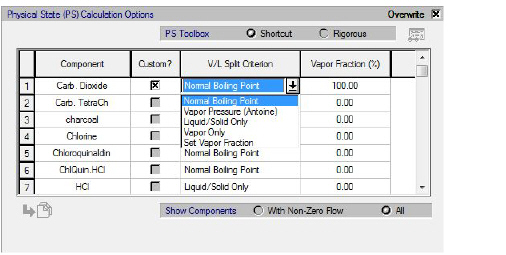
The Physical State calculation options tab for a bulk stream.
|
|
By alternating between the Show Components With Non-Zero Flow and All options, you request to view (or omit) the components that have zero flow, and therefore do not actually affect the composition of a stream. |
► How to customize the Rigorous Toolbox options...
1. While in select mode (the  button is pressed on the main toolbar), double-click on the specific stream whose options you wish to change or right-click in the stream and select Simulation Data.
button is pressed on the main toolbar), double-click on the specific stream whose options you wish to change or right-click in the stream and select Simulation Data.
2. Visit the Physical State tab.
3. Check the Overwrite checkbox in the Physical State (PS) Calculation Options frame.
4. Make sure the Rigorous Toolbox option is selected.
5. Click on the Edit Rigorous Toolbox Options button  .
.
6. In the Rig. Toolbox dialogue that appears (The Rigorous Toolbox dialog.), specify the desired VLE model from the K-value calculation model drop-down list (see The Rigorous Physical State Calculation Toolbox for more details).
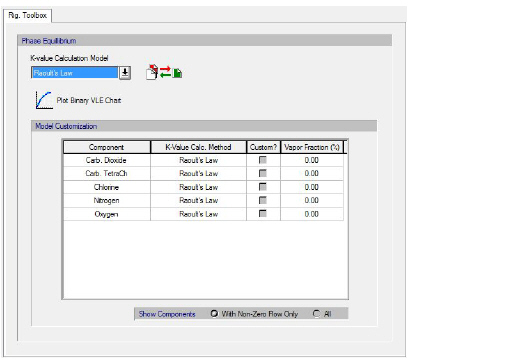
|
|
Streams that are outputs of Rigorous toolbox-only procedures have their PS determined by the procedure itself. The PS calculation options of such streams cannot be overwritten (see Rigorous Toolbox-Only Unit Procedures). |
For each bulk stream, SuperPro Designer calculates the individual densities of the liquid/solid and vapor phase (see Density Calculation Options) as well as the total density of the stream. By default, every stream in the process is initialized with the density calculation options of the process file (unit procedures do not keep a set of default options for density calculations) and any change to the options of the process file will be propagated to the stream. It is possible to deviate from the default settings for the calculation of density in one of the following ways:
1. Modify the liquid/solid density calculation options
2. Modify the vapor density calculation options
|
|
When the Overwrite check box is checked, the density calculation options of the stream become independent of the respective options of the process file. As a consequence, possible changes to the density calculation options of the process file will not be propagated to the stream. |
► How to overwrite the Density Calculation Options...
1. While in select mode, double-click on the specific stream whose physical options you wish to change.
2. Visit the Physical State Options Tab.
3. Check the respective Overwrite checkbox for the Liquid/Solid or Vapor Density (The input stream’s density options).
4. Make the desired changes regarding user-set density values, volumetric coefficients, etc.

The input stream’s density options
|
|
The density options for a bulk input stream are identical to the options available for intermediate and output streams unless the input stream’s composition is just a single ingredient that happens to be a stock mixture. In that case there is one extra choice for the liquid/solid density model: ‘Use Stock Mixture’s Density Correlation’. If chosen, then the application will calculate the density of the stream with the density options of the stock mixture (seeStock Mixture: Composition & Density). |
In order to calculate the pH of an aqueous solution containing multiple different species, a system of nonlinear algebraic equations must be solved simultaneously. Since species concentrations may differ by many orders of magnitude, the direct numerical solution in concentration space may be unstable.
To improve numerical stability, all concentrations are expressed in logarithmic variables Si:
|
|
eq. (4.1) |
where Ci is the molar concentration of component i. This ensures that the unknowns remain on a comparable numerical scale and avoids underflow for very small concentrations.
Electroneutrality equation
For a system containing nsp species, each with degree of dissociation dj, the electroneutrality equation has the following form:
|
|
eq. (4.2) |
where, SH+ is the logarithmic concentration of proton ions, SOH- is the logarithmic concentration hydroxide ions and zjk and Sjk are the charge and logarithmic concentration of the protonated/deprotonated form k of species j, respectively. Notice that for base components zjk = k while for acid components zjk = -k.
Water Ionization
The water ionization equation in logarithmic form is:
|
|
eq. (4.3) |
where, Kw = 10-14.
Mass Balance
For each species j with initial concentration Cj,init, the mass balance is expressed by the following equation:
|
|
eq. (4.4) |
Equilibrium Equation
Each dissociation step contributes an equilibrium equation. For acid components the equilibrium equation is
|
|
eq. (4.5) |
and for bases the equilibrium equation is
|
|
eq. (4.6) |
All environmental properties of the stream are always calculated based on the composition of the stream and the environmental contribution factors of the components that are present in the stream (see Pure Component: Aqueous Properties). They are presented (for viewing only) on the Bulk Stream Dialog: Env. Properties tab.
|
|
This tab may not be shown (for all streams). Since environmental assessment properties are only pertinent to users whose main focus lies in that area, and not to all other users, there is an option to hide all such information (for simplicity) from all other users. The option is part of the dialog that appears when selecting Preferences } Miscellaneous... from the flowsheet’s context (right-click) menu. Please note that when this tab is not shown on streams, the “Aqueous Prop” tab of a pure component’s definition dialog is not shown either. |
The dialog displays the concentrations (in mg/L) and daily throughputs (kg/day) of the following environmental properties:
● Total Organic Carbon (TOC)
● Total Phosphorous (TP)
● Total Kjeldahl Nitrogen (TKN)
● Ammonia Nitrogen (NH3)
● Calcium Carbonate (CaCO3)
● Nitrate/Nitrite Nitrogen (NO3-NO2)
● Chemical Oxygen Demand (COD)
● Theoretical Oxygen Demand (ThOD)
● Ultimate Biochemical Oxygen Demand (BODu)
● 5-Day Biochemical Oxygen Demand (BOD5)
● Total Solids (TS)
● Total Suspended Solids (TSS)
● Volatile Suspended Solids (VSS)
● Degradable Volatile Suspended Solids (DVSS)
● Total Dissolved Solids (TDS)
● Volatile Dissolved Solids (VDS)
● Degradable Volatile Dissolved Solids (DVDS)